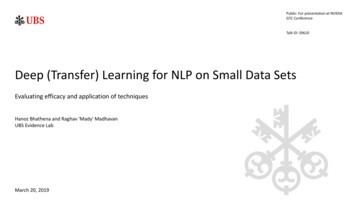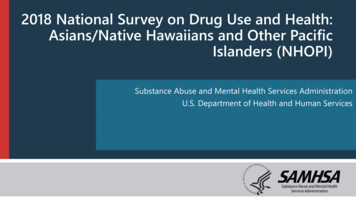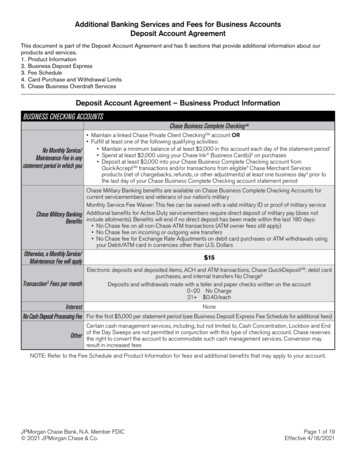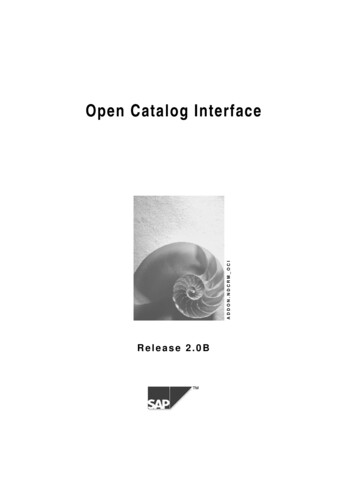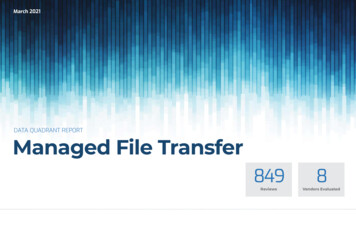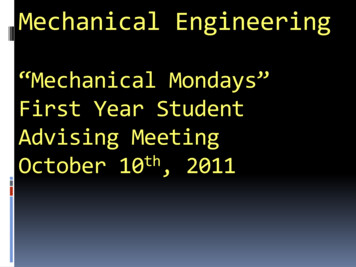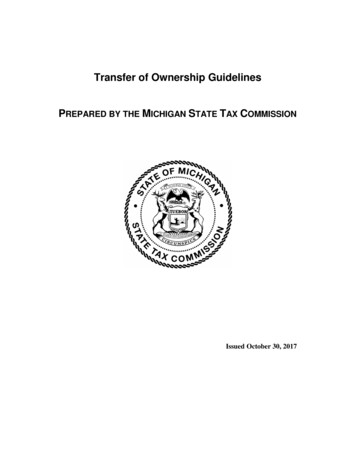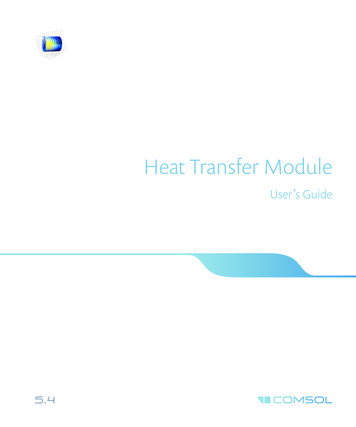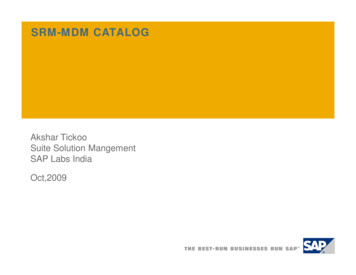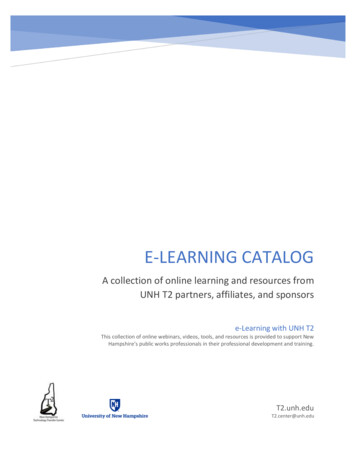
Transcription
E-LEARNING CATALOGA collection of online learning and resources fromUNH T2 partners, affiliates, and sponsorse-Learning with UNH T2This collection of online webinars, videos, tools, and resources is provided to support NewHampshire’s public works professionals in their professional development and training.T2.unh.eduT2.center@unh.edu
ContentsIntroduction . 3About the Content . 3Accessing Content . 3AASHTO Transportation Curriculum Coordination Council (TC3) . 3APWA Click, Listen, and Learn and APWA Members’ Library . 3FHWA webinars . 4Montana LTAP . 4National Highway Institute (NHI) . 4Ohio LTAP eLearning System. 4Technical or Other Difficulties Accessing e-Learning . 4Using This Catalog. 4Future Updates . 5Bridge Preservation and Maintenance . 7CDL Pretrip Inspection .12Chainsaw Safety .13Communication .13Confined Space .15Culvert Installation .15Data Driven Safety Analysis .17Drones.17Erosion Control .17Ethics.18Excavations and Trenching .19First Aid and General Safety .22Flagger and Work Zone Safety & Awareness .24Funding .28Garage Safety.29Gravel Roads .30Green Infrastructure .31Guardrail Design, Installation, Maintenance and Inspection .32Heavy Equipment Safety and Operation .33Leadership .35Math for Public Works .36Mowing & Roadside Vegetation .37Pavement Construction, Management, and Preservation .38Plan Reading .46Public Relations for Public Works .47Roadway Safety .48
Stormwater Control .53Summer Safety .56Traffic Incident Management (TIM) .56Tree Trimming .59Welding. Error! Bookmark not defined.Winter Maintenance .59Index of Course Title Keywords .67
IntroductionUniversity of New Hampshire’s Technology Transfer Center (UNH T2) is the site of New Hampshire’s Local Technical AssistanceProgram (LTAP) Center. Through our FHWA sponsors, state and national partners, affiliates, and LTAP friends, we’ve been able tocreate this listing of online courses and resources – also called eLearning, or Web-based training (WBT) – to enhance New HampshirePublic Works’ professionals’ training opportunities. Local road agencies and employees can use these courses in many ways; as partof a mandatory training plan, to increase their general professional development or knowledge, or to supplement classroom andother learning. This catalog provides detailed descriptions and links to almost 400 online courses, documents, and other resources,broken out by almost 30 transportation topics. Many of these courses and materials are generously made available at no-cost(FREE!) to our customers from our partners and sponsors! Access to this content, including any costs associated, is subject tochange. While UNH T2 will do its best to maintain this catalog, please refer to the content’s provider for additional information, orcontact T2.Center@unh.edu.About the ContentThis catalog includes previously-recorded webinars, videos, Tailgate Talk resource documents, and on demand online trainingmodules and webinars. This is in addition to the variety of in-person workshops and webinars UNH T2 and our partners host live!Please monitor our Training Calendar for upcoming events!Accessing ContentThe following providers (including some in conjunction with FHWA) are offering their online content at no cost for the datesindicates (subject to change). Please contact T2.Center@unh.edu to inquire about any necessary promotional codes, as applicable.AASHTO Transportation Curriculum Coordination Council (TC3)FREE ACCESS TO TC3 COURSES FOR LOCAL ROAD AGENCIES ! E MAIL t2.center@unh.edu FOR PROMO CODE !If a course offers professional development hours (PDHs), you will see the PDHs on your course completion certificate, which alsoserves as documentation of your attendance. PDH requirements vary, therefore, it is up to you to determine whether this particularcourse qualifies under your State or board requirements.SPECIAL INSTRUCTIONS: Please note that all TC3 courses are Flash based. Therefore, you must enable your browser to allow Flashfor the AASHTO Store and AASHTO learning system that hosts TC3 courses. If the screen is blank or shows the message, “Make aSelection to Continue,” Flash is not enabled for TC3 courses. The easiest way to enable Flash is to select the lock icon next to the URLfor the course and change the Flash settings to “Allow.”Through a special partnership with FHWA and TC3, local road agencies can access the TC3 online learning at no cost! You will need an AASHTO account to access the online training courses.o Please go to https://store.transportation.org/and select Register, and then enter your agency’s email address tocreate an AASHTO account. Access to TC3 learning modules free is easiest with a local agency or government email address, but let T2staff know if you are using a personal email address or other non-government or non-municipal emailaddress, or if you have any trouble accessing content with the promotional codes.o A YouTube video walks through the process at https://www.youtube.com/watch?v NcFONY2R78s To gain unlimited access to the curriculum at no cost, contact T2.Center@unh.edu for the special local agency promotionalcode. After you have added a course to your cart you will be able to apply the promotion code in your cart To browse and gain access to the TC3 course offerings, go to https://tc3.transportation.org/.Please note that the development of the TC3 Anti-icing/Road Weather Information System (RWIS) training series by the Snow andIce Pooled Fund Cooperative Program (SICOP) was made possible through the pooled fund contributions by SICOP member statesand other interested entities. It is being made available here through a partnership between SICOP and the TransportationCurriculum Coordinating Council (TC3).APWA Click, Listen, and Learn and APWA Members’ Library*NEW* APWA is offering access to its Member Library and Click, Listen, and Learn content FREE to allpublic works professionals through May 25, 2020!
CLLs are APWA’s webinar series of interactive internet educational programs. Each program is led by top experts in the fieldwho convey new ideas, new methods, and new technologies in a fast-paced one-hour time frame.Through NH LTAP's APWA membership, we are pleased to schedule a Lunch and Learn or other opportunity to review Click,Listen, and Learn content with your team! Contact Marilee LaFond to schedule.Click for more info on APWA Click, Listen, and LearnFHWA webinarsFHWA offers webinars and resources on a variety of transportation topics. If you’re asked for your credentials, click Cancel and itshould then switch to Adobe Connects.Montana LTAPThe Montana LTAP at Montana State University offers a variety of recorded webinars on various safety and other topicsNational Highway Institute (NHI)NHI is celebrating 50 years of transportation training in 2020! To celebrate this, all web-based training courses are freeto access for a limited time!Click for more info on NHIOhio LTAP eLearning SystemYou will need to request access to the Ohio LTAP eLearning system. eLearning works best with the Chrome web browser. Forfurther info, review these instructions.Technical or Other Difficulties Accessing e-LearningWhile most users have no trouble enrolling in these online learning opportunities and successfully launch the courses to completethe training, there are occasional situations where a user’s computer or network setting is incompatible with the e-learning. Pleasecontact T2.Center@unh.edu if you have any trouble accessing this content, including trouble creating a user account, selecting andenrolling in courses, and accessing or completing courses. We’re here to help, and if you are encountering difficulties with access,there’s a strong chance someone else might encounter the same!Using This CatalogA Table of Contents (front section) and Index (back section) are provided for easy reference. When viewing the electronic (PDF)version of this catalog, customers can also quickly search for specific keywords or topics using the Find feature.Simply use “Ctrl” “F” on the keyboard to open the Find box:
Then type in a keyword to search, and use the Enter/Return key to go to the first use of the word:Clicking on the “Next” button will then move to the next instance of the word where it’s used in the Catalog (PDF document).Have 30 minutes? You can still take some training! We’ve used the following symbols to identify quick hits of training, such as aTailgate Talk or a webinar or learning module of 30 minutes or less, as well as to identify content that is mobile-friendly or a staffrecommendation.Represents a short video, a Tailgate Talk, or other fast readRepresents a course title (webinar or other learning module) that is 15 minutes or lessRepresents a course title (webinar or other learning module) that is 30 minutes or less”Staff picks” - content we’ve reviewed and think is particularly relevant to New Hampshire’s local road agenciesMobile-friendly resource or learning module, that you can take from your mobile deviceFuture UpdatesThis catalog will be updated periodically to capture updated or additional courses and content access details. This version includesupdates as of 4/1/2020. For the most current listing of available online courses and access details (including costs), please refer tothe content providers’ websites, or contact t2.center@unh.edu.
Bridge Preservation and Maintenance2015 FHWA Replacement & Rehabilitation Costs for Structurally Deficient (SD) Bridges as captured on TSP2 Bridge PreservationWork Group siteThe attached spreadsheet contains the 2015 FHWA replacement ad rehabilitation costs for SD bridges. National average unit costsfor SD bridge replacement are 209/ft² for NHS and 188/ft² for non-NHS.Bridge Corrosion Mitigation Topics from TSP2Bridge Deck Preservation Topics from TSP2Bridge Joints & Bearings Topics from TSP2Bridge Local Agencies Topics from TSP2Bridge Paint & Coatings Topics from TSP2Bridge Scour & Emergency Response from TSP2Bridge Maintenance Fundamentals from NHI (4.0 hrs.)When the average citizen commutes to work or runs errands, they are relying on us, public transportation agencies, to keep theirbridges safe and available for use. It is their expectation that we keep their bridges serviceable and at the lowest life-cycle costpossible. Bridge management systems will help your agency to efficiently balance the various bridge needs against availableresources. The Bridge Management Fundamentals course describes a bridge management system and walks through the process ofselecting and implementing the right bridge management software for your agency. Throughout the course, you will learn directfrom agencies with mature and successful bridge management systems about how they get the most utility from their system.Training Level: BasicTarget Audience:The target audience includes Federal, State, and local bridge program managers; bridge management engineers; bridgemanagement practitioners; transportation planners; and project planning and programming personnel. Additionally, transportationperformance management team members, transportation asset management team members, bridge preservation and maintenanceengineers, the financial management team, bridge inspectors, and bridge designers may benefit from this training. All participantsshould have knowledge of basic bridge terminology.Learning Outcomes: Explain the need for a BMS Describe a typical BMS organizational structure Describe the seven components of a BMS Describe tools that are used as part of the bridge management process Describe an implementation plan for a comprehensive BMS Describe effective practices when using BMSs Identify successful applications of BMS components by agencies Describe the bridge management process as it relates to an agency business model Describe how to address riskBridge Maintenance Painting from NHI (4.0 hrs.)NHI-130107B Maintenance Practices of Bridge Painting will support a geographically dispersed audience with varying amounts ofexperience and education who have responsibility for maintaining coatings of in-service bridges. Learners will gain basic knowledgeof the corrosion process, paint and corrosion evaluations, maintenance coating design options, and the most frequently usedmethods for surface preparation and application of maintenance painting materials.Training Level: BasicTarget Audience: Primarily members of Federal, State, and Local Departments of Transportation, as well as contractors performingwork on behalf of these agencies, individuals involved in onsite bridge maintenance activities and those that supervise and managethese activities. This training is appropriate for those who possess basic knowledge of bridge maintenance activities and wish to gainspecific expertise in bridge painting practices. Participants should possess basic knowledge of bridge maintenance and repairactivities at a minimum before taking this course.Learning Outcomes: Explain the importance of bridge painting as a bridge preservation activity
Describe preventive maintenance coating systems used on bridgesDescribe current preventive maintenance bridge painting practicesBridge Preservation Fundamentals from NHI (5.0 hrs.)Bridge Preservation Fundamentals (130106A) provides the participant key bridge preservation strategies that can help assist in theplanning and implementation of their own bridge preservation program. It is a six-lesson course that starts off with introducingdefinitions, terminology, and categories of bridge action. It also shares details on the benefits of timely bridge preservation and theconsequences of deferred maintenance. This course discusses at length user best practices and activities related to deckpreservation, superstructure preservation, and substructure preservation. This course also includes a lesson with detail on costeffective culvert preservation practices.This course is the first course in the three-course Bridge Preservation Web-based Training (WBT) series which includes Establishing aBridge Preservation Program (130106B) and Communication Strategies for Bridge Preservation (130106C). This course series coversareas such as concepts of bridge preservation; how to establish and maintain a good bridge preservation program; best practices;common treatments and strategies; and resource management strategies (in-house vs. contract). The goal of the BridgePreservation WBT Series is to provide training to bridge owners and those that are responsible for managing and maintaining thebridge inventory on the principles of planning and implementing successful bridge management and preservation programs.Training Level: BasicTarget Audience: Individuals involved in the development, implementation, and delivery of a bridge preservation program. Thiscourse is intended for those with general knowledge and/or skills in the area of bridge maintenance and management principles andpractices.Learning Outcomes: Define activities and classifications related to bridge preservation, and associated work categories of rehabilitation,preventive maintenance, and systematic preventive maintenance Identify the benefits of timely bridge preservation activities, consequences of deferred maintenance, and strategies totransition bridge programs from reactive to proactive Determine cost-effective deck preservation practices and activities Determine cost-effective superstructure preservation practices and activities Determine cost-effective substructure preservation practices and activities Determine cost-effective culvert preservation practices and activitiesBridge Preservation Video as captured on TSP2 Bridge Preservation Work Group site (8 min.)Bridge Preservation – Bridge owners across the United States face significant challenges in addressing the needs of the aginginfrastructure. This vide explains bridge preservation activities and which ones qualify for Federal funding. Also, learn howtransportation agencies in four states established their bridge preservation programs and what advice they have for other agencies.Bridge Preservation Guide from TC3 (1.5 hours)This course follows the Bridge Preservation Guide that was developed for Federal, State, and local bridge engineers, bridge owners,and bridge preservation practitioners to support the Federal-aid Highway Program. The Bridge Preservation Guide: Maintaining aResilient Infrastructure to Preserve Mobility was created because many State DOTs, local agencies, and other bridge owners facesignificant challenges in addressing the needs of their aging infrastructure.A successful bridge program seeks a balanced approach to preservation and rehabilitation or replacement. Bridge owners arestriving to be more strategic by adopting and implementing systematic processes for bridge preservation as an integral componentof their overall asset management.This course is divided into two modules. Module 1 covers definitions and commentaries, which will assist as a means of establishingclear and consistent terminology for bridge owners and preservation practitioners. Module 2 covers establishing a bridgepreservation program.Training level: This training is recommended for the Transportation Curriculum Coordination Council levels I, II, III, and IV.Target audience: This course targets technicians involved in the maintenance of in-service highway structures.Learning outcomes: Upon completion of this course, participants will be able to: Explain the challenges of preserving and maintaining bridges and culverts; Describe how bridge preservation and maintenance activities qualify for Federal funding; Define various terms used in bridge preservation; Explain the difference between cyclical and condition-based maintenance; Explain how the National Bridge Inventory General Condition Ratings are used; and Explain the difference between design life and service life; Describe the purpose of a bridge preservation program; and
Explain how to establish a bridge preservation program.Bridge Preservation Video Library from TSP2Communication Strategies for Bridge Preservation from NHI (3 hrs.)Training level: BasicTarget audience:Individuals involved in communications with highway infrastructure stakeholders and the general public.Learning objectives: Determine the strategies required to identify an agency champion and the target customers and stakeholders for a bridgepreservation program Recognize strategies for developing bridge preservation messages that capture values, benefits and needs, intended forhighway infrastructure stakeholders and the general public Determine strategies for communicating bridge preservation messages that capture values, benefits and needs, intendedfor highway infrastructure stakeholders and the general public Summarize key activities involved in performing market research, as it applies to a bridge preservation program.Part 3 of the three-course Bridge Preservation Web-based Training (WBT) series which includes Bridge Preservation Fundamentals(130106A) and Establishing a Bridge Preservation Program (130106B).This course series covers areas such as concepts of bridge preservation; how to establish and maintain a good bridge preservationprogram; best practices; common treatments and strategies; and resource management strategies (in-house vs. contract). The goalof the Bridge Preservation WBT Series is to provide training to bridge owners and those that are responsible for managing andmaintaining the bridge inventory on the principles of planning and implementing successful bridge management and preservationprograms.Concrete Bridge Deck Patching from AASHTO TC Just-in-Time video (4 min.)This video covers bridge deck patching using concrete patches. These are normally small, immediate, and safety-related repairs thatare completed by using fast curing concrete. This video has been provided courtesy of the Virginia Department of Transportationwith permission for viewing on TC3’s YouTube channel. Note that this video may include some state-specific verbiage; however, thecontent is beneficial to technical staff involved in highway operations regardless of geographic location. Anyone viewing this videoshould refer to their agency specifications and requirements, which they need to review and follow.Dimensional Stability of Grout-Like Materials Used in Field-Cast Connections as captured on TSP2 Bridge Preservation Work GroupsiteThe wide use of grouts and grout-like materials in the construction industry is seen in applications such as joint sealing, structuralrepair, and connections in prefabricated bridge elements (PBEs). Currently, different types of grouts are available (e.g., epoxy-based,cementitious-based, etc.). The selection of the most appropriate grout type is commonly based on the application in which it is usedand the desired performance. Grouts for transportation applications typically require high-performance properties such as rapidstrength development and superior durability characteristics. However, dimensional stability issues (i.e., expansion and shrinkage)have been observed in various applications with different grout types but especially in cases where cementitious grouts were used,due mainly to their inherent shrinking behavior. This document provides information about the current approaches to quantifyingthe dimensional stability of grouts and grout-like materials, including those cementitious grouts known as “non-shrink cementitiousgrouts (NSCGs),” and highlights some of the limitations of the test methods currently in use. Additional material testing methods tobetter quantify dimensional stability are also proposed, as well as strategies to help mitigate some of the shrinkage observed inthese types of materials.Establishing a Bridge Preservation Program from NHI (4.0 hrs.)Establishing a Bridge Preservation Program (130106B) focuses on efforts in developing a bridge preservation program. This courseincludes a lesson on the establishment of goals, objective and performance measures in a bridge preservation program. The coursegoes in-depth into the needs assessment and data management process, including the creation of a bridge preservation strategy,and it outlines the prioritization process. A lesson on budgeting and resource allocation describes the linkage between data tobudgeting and resource allocation activities. The course also includ
E-LEARNING CATALOG A collection of online learning and resources from UNH T2 partners, affiliates, and sponsors T2.unh.edu T2.center@unh.edu e-Learning with UNH T2 This collection of online webinars, videos, tools, and resources is provided to support New Hampshires public works professionals in their professional development and training.
